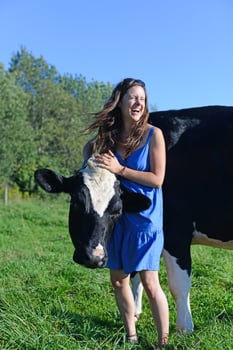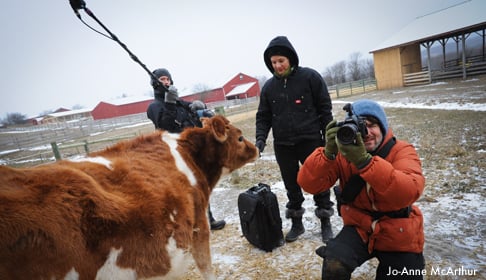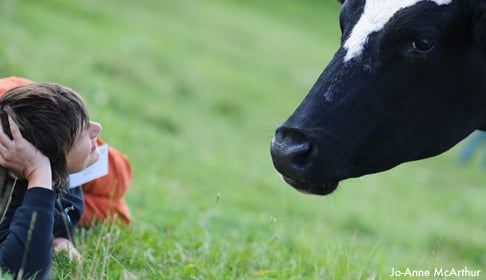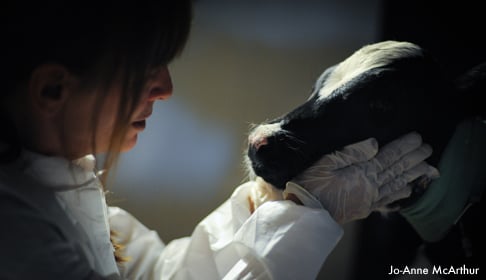The Ghosts in Our Machine is a film about a complex social dilemma. As described on the film’s website, humans have cleverly categorized non-human animals into three domains: domesticated pets, wildlife, and the ones we don’t like to think about — the “ghosts in our machine.” During production in 2012, our national shelter director, Susie Coston, sat down with director Liz Marshall to talk about the film. The Ghosts in Our Machine will soon enjoy its theatrical release in the United States, starting in New York, November 8–14, at the Village East Cinema and in the Los Angeles area, November 15–21, at Laemmle Theatre, Music Hall 3, in Beverly Hills. For more information and show locations, visit the film’s website.
This post was originally published on March 12, 2012.
By Susie

Photojournalist Jo-Anne McArthur with her pal, Sonny.
I often meet artists who are passionate about animal causes, and I love introducing them to the animals who call Farm Sanctuary home. Over the last year or so, we’ve been especially fortunate to get to know filmmaker Liz Marshall, and I want to share her upcoming project, The Ghosts in Our Machine, with you. Ghosts, as we often call it, is a documentary that follows the work of photographer and animal advocate Jo-Anne (Jo) McArthur, and it features some Farm Sanctuary residents. Here’s what Liz had to say when I asked about her work and Jo’s:
Susie: What is The Ghosts in Our Machine?
Liz: Well, with the exception of our cats and dogs and a few wild and stray species within our day-to-day living environments, we primarily encounter animals as food, clothing, research, and entertainment.
We don’t fully realize how and where our lives intersect with animals, and that makes these animals “ghosts” in our modern world. The Ghosts in Our Machine is a feature-length film that illuminates the lives of these “ghosts” — individual animals, hidden from our view, living within or rescued from the consumer-driven machine.
Through the heart and photographic lens of animal rights protagonist Jo-Anne McArthur, we become intimately familiar with a small cast of animal characters. These individuals represent just a few of the countless animals we too often unknowingly affect in devastating ways. We hear from a spectrum of voices about the cognitive and emotional complexity of animals and about globalized animal industries — scientists, doctors, and industry representatives also contribute to the story.

Filming at our New York Shelter.
Susie: How did you and Jo decide to work together on this project?
Liz: Working with Jo is a natural fit since we are both longtime documentarians committed to social justice. Jo’s photographic body of work, We Animals, initially inspired me, and then I quickly realized it would make an interesting story to feature Jo-Anne as the main human subject of a film.
I approached Jo in early 2009 about the possibility of collaborating on a feature documentary, but it wasn’t until later in 2010 that things fell into place. In this project, Jo’s lens is an intimate, honest portal into the lives of these “ghosts,” and she is at a critical juncture in her own activist–photographer career. While Jo’s work is celebrated within the worldwide animal rights community, it’s a treasure not known to a wider audience.The animals’ stories involve struggle, and Jo’s does too.
Part of the story follows Jo as she works with her photo agency in New York City to pitch her work to mainstream publications. Her work is happening at a time when issues pertaining to animal rights are in the public eye — there is a groundswell of consumer interest in health and compassion. But, while we’re seeing these issues gain a foothold in popular culture, the animal rights movement, itself, is often misunderstood and marginalized. People still do not want to “see” how their consumer behavior affects billions of animals. The film reflects this wave of consciousness and conflict and is also part of it.

Filmmaker Liz Marshall with Fanny.
Susie: How did your connection with Farm Sanctuary come about?
Liz: We (Ghosts Media) are so excited about our growing relationship with Farm Sanctuary. My introduction to the sanctuary was a very magical, unforgettable visit in 2004. It naturally inspired one of the stories featured in the film: the rescue and rehabilitation of Sonny.
This story highlights the realities of the dairy and veal industries and the very special work that Farm Sanctuary does. Jo is a close friend of Farm Sanctuary — as she says in the film, “It is my home away from home.” It’s thanks to Jo that we’ve had such access to the sanctuaries and the animals.

National Shelter Director Susie Coston with Sonny shortly after his rescue.
Susie: What do people most need to know about farm animals and our food system?
Liz: I love Bruce Friedrich’s [Farm Sanctuary Senior Director for Strategic Initiatives] ongoing Facebook messaging — he posts an image of a farm animal and says “Someone, not Something.” This about sums it up for me. The animals we use for food, research, clothing, and entertainment are individuals who possess emotions and intelligence; they are not inanimate objects. Like many social movements, animal rights can feel like an upward battle, but it is helping to expand compassion in our world. Slowly but surely, these “ghosts” will become known in the consciences of many, many consumers.
Watch the trailer below or visit theghostsinourmachine.com:

such important, courageous work; so grateful for your efforts